Developing a Two-Week Menu for Sparkling Stars Childcare (3-5)
VerifiedAdded on 2021/04/19
|27
|5725
|496
Practical Assignment
AI Summary
This assignment requires the development of a two-week menu for children aged 3-5 at Sparkling Stars Childcare Centre, adhering to specific dietary guidelines, ingredient variety, and cultural considerations. The assignment also includes case studies addressing sleep and rest practices, safe work practices, promoting safety awareness, and managing allergies, asthma, and anaphylaxis in a childcare setting. Students are tasked with creating checklists, posters, and video recordings demonstrating appropriate responses to various scenarios, including medication administration and emergency procedures. The assessment emphasizes the importance of following established policies and procedures to ensure the health, safety, and well-being of children in the childcare environment. The assignment covers multiple aspects of early childhood education, including nutrition, health, and safety protocols.
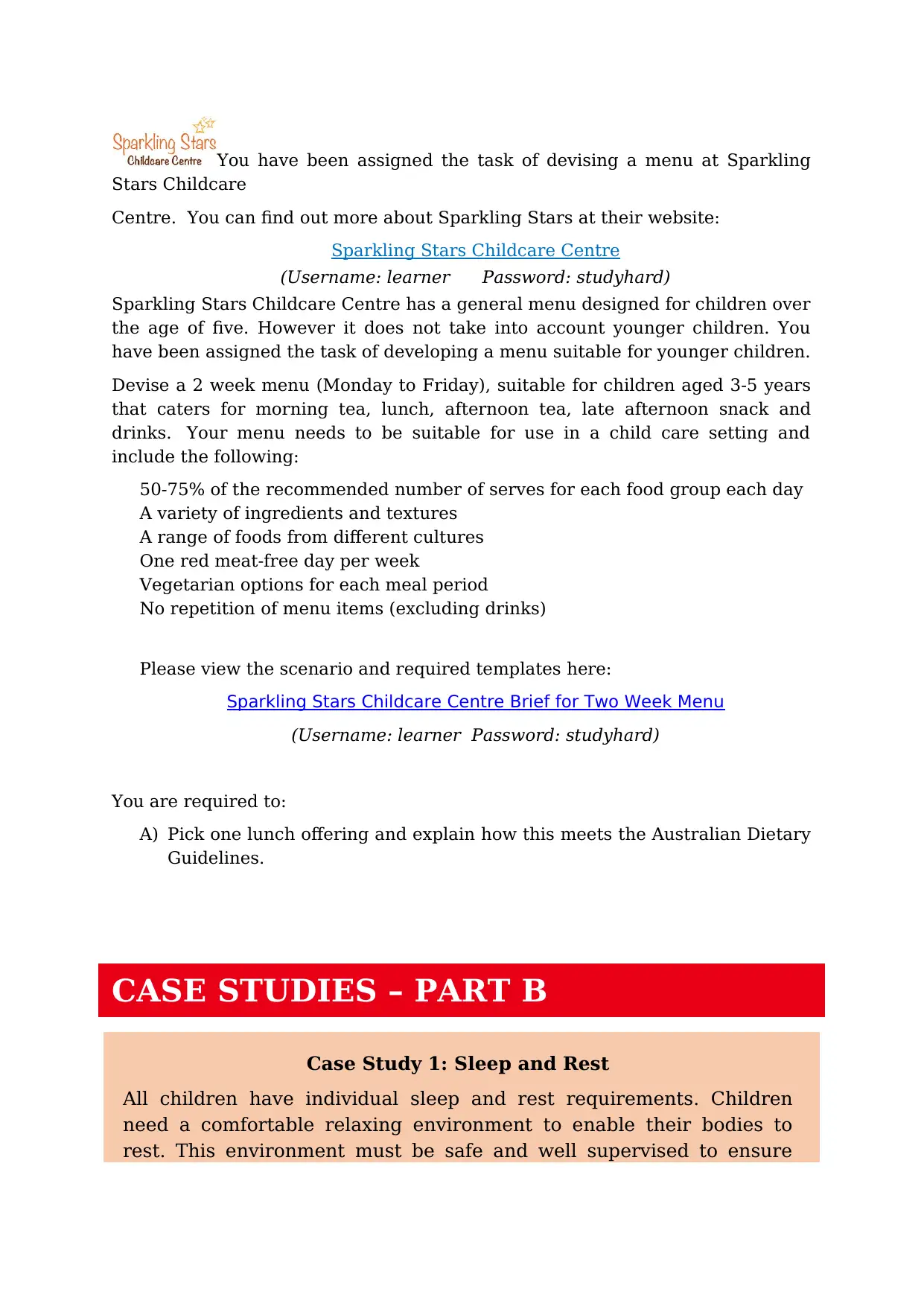
You have been assigned the task of devising a menu at Sparkling
Stars Childcare
Centre. You can find out more about Sparkling Stars at their website:
Sparkling Stars Childcare Centre
(Username: learner Password: studyhard)
Sparkling Stars Childcare Centre has a general menu designed for children over
the age of five. However it does not take into account younger children. You
have been assigned the task of developing a menu suitable for younger children.
Devise a 2 week menu (Monday to Friday), suitable for children aged 3-5 years
that caters for morning tea, lunch, afternoon tea, late afternoon snack and
drinks. Your menu needs to be suitable for use in a child care setting and
include the following:
50-75% of the recommended number of serves for each food group each day
A variety of ingredients and textures
A range of foods from different cultures
One red meat-free day per week
Vegetarian options for each meal period
No repetition of menu items (excluding drinks)
Please view the scenario and required templates here:
Sparkling Stars Childcare Centre Brief for Two Week Menu
(Username: learner Password: studyhard)
You are required to:
A) Pick one lunch offering and explain how this meets the Australian Dietary
Guidelines.
CASE STUDIES – PART B
Case Study 1: Sleep and Rest
All children have individual sleep and rest requirements. Children
need a comfortable relaxing environment to enable their bodies to
rest. This environment must be safe and well supervised to ensure
Stars Childcare
Centre. You can find out more about Sparkling Stars at their website:
Sparkling Stars Childcare Centre
(Username: learner Password: studyhard)
Sparkling Stars Childcare Centre has a general menu designed for children over
the age of five. However it does not take into account younger children. You
have been assigned the task of developing a menu suitable for younger children.
Devise a 2 week menu (Monday to Friday), suitable for children aged 3-5 years
that caters for morning tea, lunch, afternoon tea, late afternoon snack and
drinks. Your menu needs to be suitable for use in a child care setting and
include the following:
50-75% of the recommended number of serves for each food group each day
A variety of ingredients and textures
A range of foods from different cultures
One red meat-free day per week
Vegetarian options for each meal period
No repetition of menu items (excluding drinks)
Please view the scenario and required templates here:
Sparkling Stars Childcare Centre Brief for Two Week Menu
(Username: learner Password: studyhard)
You are required to:
A) Pick one lunch offering and explain how this meets the Australian Dietary
Guidelines.
CASE STUDIES – PART B
Case Study 1: Sleep and Rest
All children have individual sleep and rest requirements. Children
need a comfortable relaxing environment to enable their bodies to
rest. This environment must be safe and well supervised to ensure
Paraphrase This Document
Need a fresh take? Get an instant paraphrase of this document with our AI Paraphraser
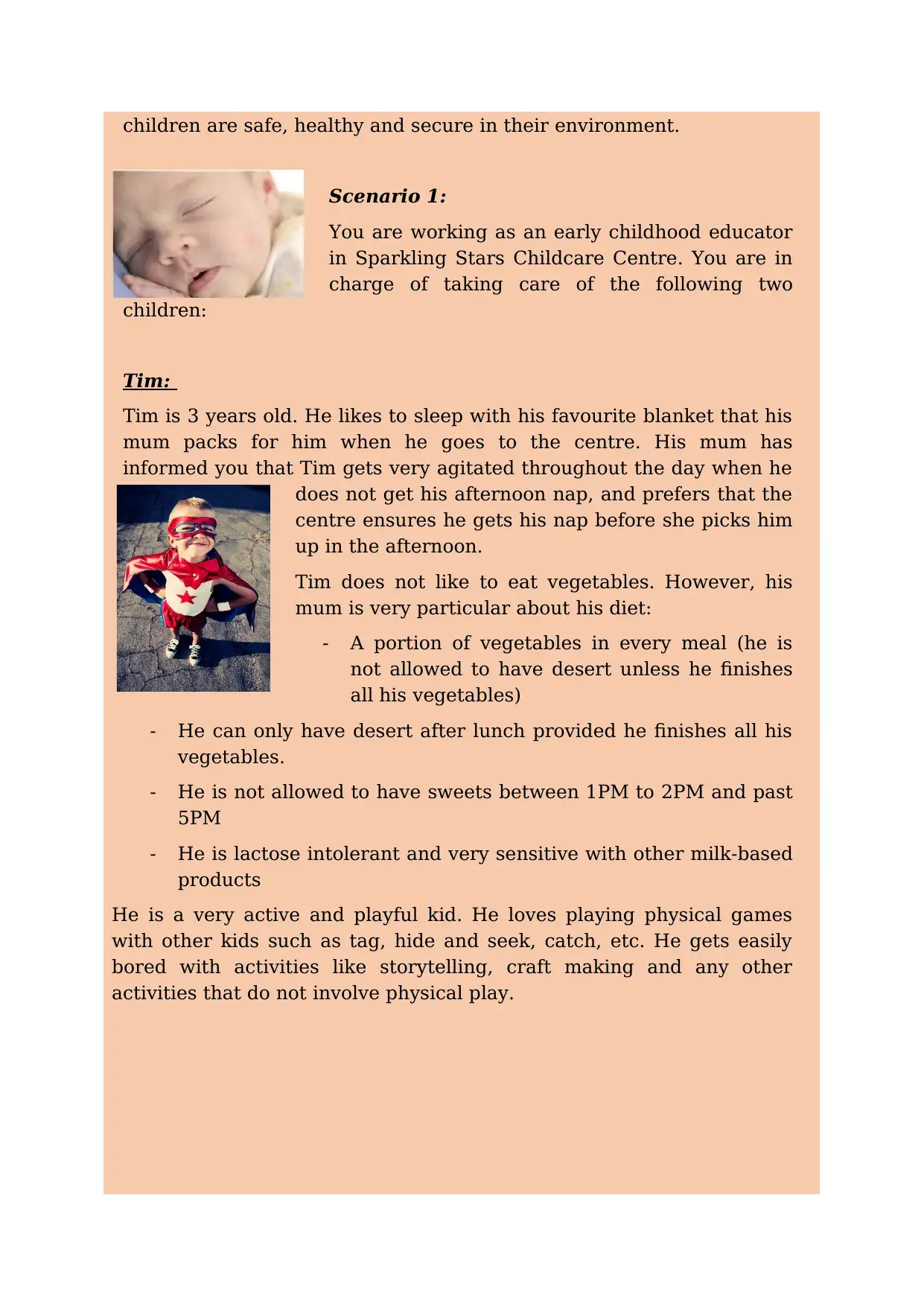
children are safe, healthy and secure in their environment.
Scenario 1:
You are working as an early childhood educator
in Sparkling Stars Childcare Centre. You are in
charge of taking care of the following two
children:
Tim:
Tim is 3 years old. He likes to sleep with his favourite blanket that his
mum packs for him when he goes to the centre. His mum has
informed you that Tim gets very agitated throughout the day when he
does not get his afternoon nap, and prefers that the
centre ensures he gets his nap before she picks him
up in the afternoon.
Tim does not like to eat vegetables. However, his
mum is very particular about his diet:
- A portion of vegetables in every meal (he is
not allowed to have desert unless he finishes
all his vegetables)
- He can only have desert after lunch provided he finishes all his
vegetables.
- He is not allowed to have sweets between 1PM to 2PM and past
5PM
- He is lactose intolerant and very sensitive with other milk-based
products
He is a very active and playful kid. He loves playing physical games
with other kids such as tag, hide and seek, catch, etc. He gets easily
bored with activities like storytelling, craft making and any other
activities that do not involve physical play.
Scenario 1:
You are working as an early childhood educator
in Sparkling Stars Childcare Centre. You are in
charge of taking care of the following two
children:
Tim:
Tim is 3 years old. He likes to sleep with his favourite blanket that his
mum packs for him when he goes to the centre. His mum has
informed you that Tim gets very agitated throughout the day when he
does not get his afternoon nap, and prefers that the
centre ensures he gets his nap before she picks him
up in the afternoon.
Tim does not like to eat vegetables. However, his
mum is very particular about his diet:
- A portion of vegetables in every meal (he is
not allowed to have desert unless he finishes
all his vegetables)
- He can only have desert after lunch provided he finishes all his
vegetables.
- He is not allowed to have sweets between 1PM to 2PM and past
5PM
- He is lactose intolerant and very sensitive with other milk-based
products
He is a very active and playful kid. He loves playing physical games
with other kids such as tag, hide and seek, catch, etc. He gets easily
bored with activities like storytelling, craft making and any other
activities that do not involve physical play.
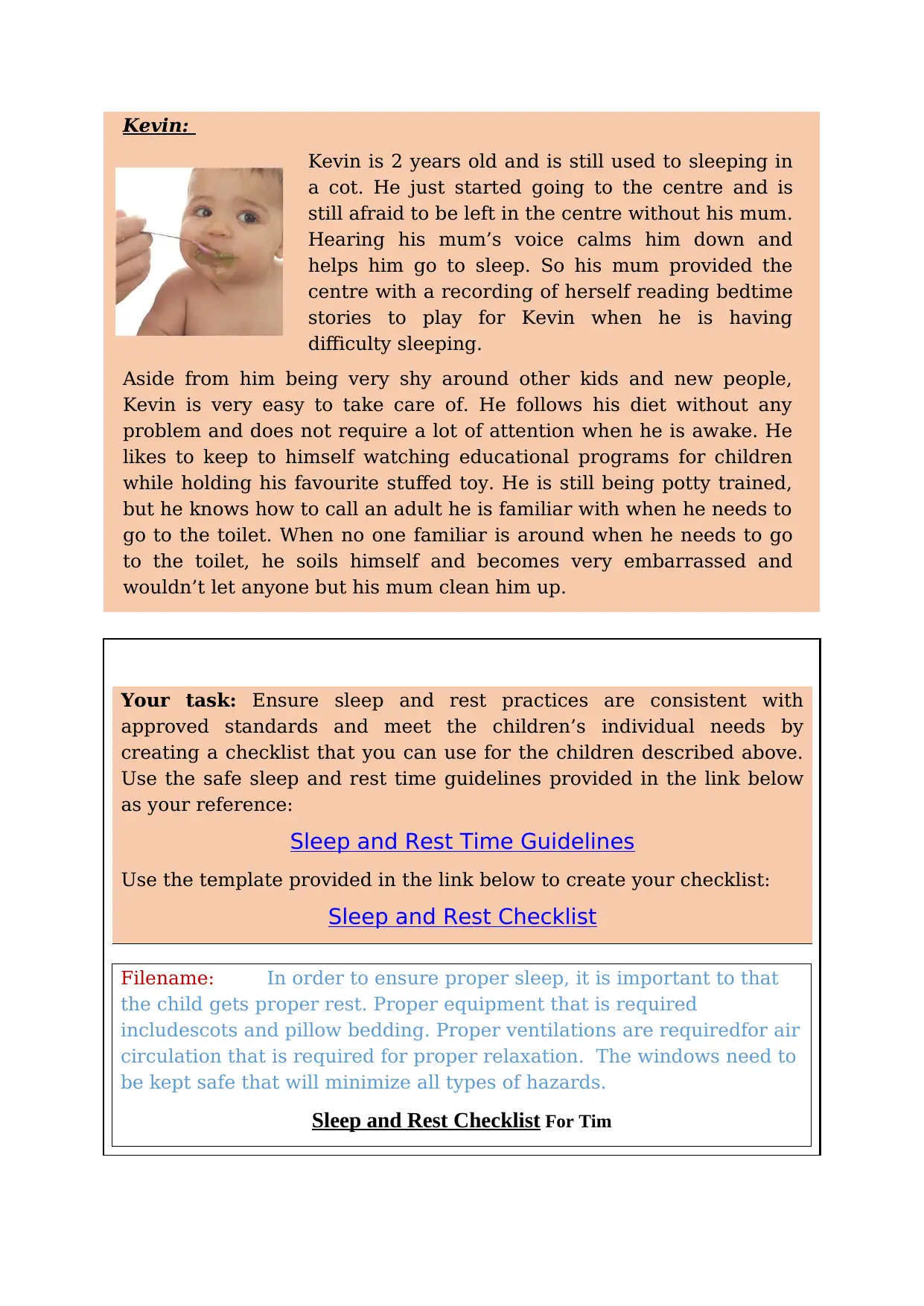
Kevin:
Kevin is 2 years old and is still used to sleeping in
a cot. He just started going to the centre and is
still afraid to be left in the centre without his mum.
Hearing his mum’s voice calms him down and
helps him go to sleep. So his mum provided the
centre with a recording of herself reading bedtime
stories to play for Kevin when he is having
difficulty sleeping.
Aside from him being very shy around other kids and new people,
Kevin is very easy to take care of. He follows his diet without any
problem and does not require a lot of attention when he is awake. He
likes to keep to himself watching educational programs for children
while holding his favourite stuffed toy. He is still being potty trained,
but he knows how to call an adult he is familiar with when he needs to
go to the toilet. When no one familiar is around when he needs to go
to the toilet, he soils himself and becomes very embarrassed and
wouldn’t let anyone but his mum clean him up.
Your task: Ensure sleep and rest practices are consistent with
approved standards and meet the children’s individual needs by
creating a checklist that you can use for the children described above.
Use the safe sleep and rest time guidelines provided in the link below
as your reference:
Sleep and Rest Time Guidelines
Use the template provided in the link below to create your checklist:
Sleep and Rest Checklist
Filename: In order to ensure proper sleep, it is important to that
the child gets proper rest. Proper equipment that is required
includescots and pillow bedding. Proper ventilations are requiredfor air
circulation that is required for proper relaxation. The windows need to
be kept safe that will minimize all types of hazards.
Sleep and Rest Checklist For Tim
Kevin is 2 years old and is still used to sleeping in
a cot. He just started going to the centre and is
still afraid to be left in the centre without his mum.
Hearing his mum’s voice calms him down and
helps him go to sleep. So his mum provided the
centre with a recording of herself reading bedtime
stories to play for Kevin when he is having
difficulty sleeping.
Aside from him being very shy around other kids and new people,
Kevin is very easy to take care of. He follows his diet without any
problem and does not require a lot of attention when he is awake. He
likes to keep to himself watching educational programs for children
while holding his favourite stuffed toy. He is still being potty trained,
but he knows how to call an adult he is familiar with when he needs to
go to the toilet. When no one familiar is around when he needs to go
to the toilet, he soils himself and becomes very embarrassed and
wouldn’t let anyone but his mum clean him up.
Your task: Ensure sleep and rest practices are consistent with
approved standards and meet the children’s individual needs by
creating a checklist that you can use for the children described above.
Use the safe sleep and rest time guidelines provided in the link below
as your reference:
Sleep and Rest Time Guidelines
Use the template provided in the link below to create your checklist:
Sleep and Rest Checklist
Filename: In order to ensure proper sleep, it is important to that
the child gets proper rest. Proper equipment that is required
includescots and pillow bedding. Proper ventilations are requiredfor air
circulation that is required for proper relaxation. The windows need to
be kept safe that will minimize all types of hazards.
Sleep and Rest Checklist For Tim
⊘ This is a preview!⊘
Do you want full access?
Subscribe today to unlock all pages.

Trusted by 1+ million students worldwide
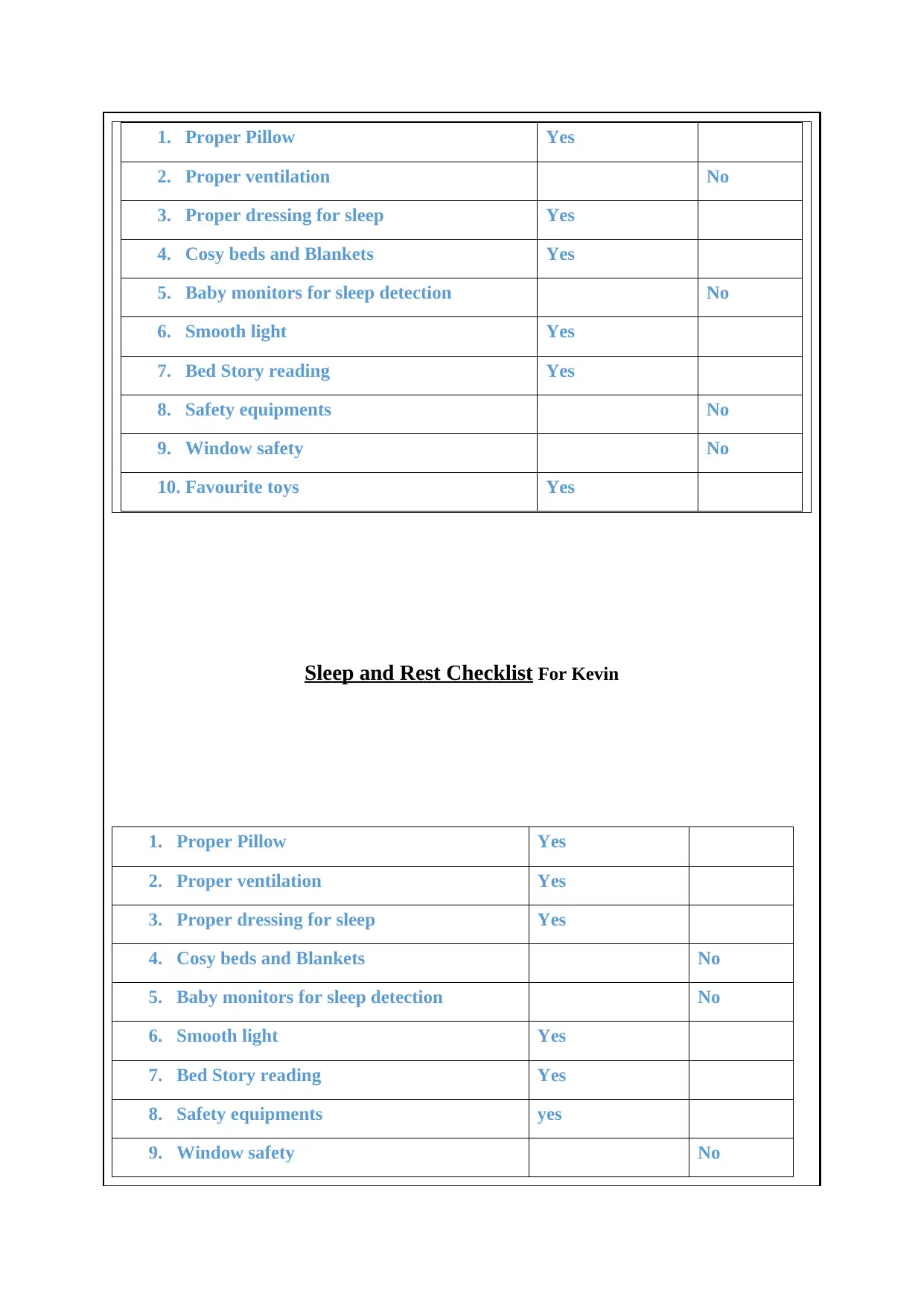
1. Proper Pillow Yes
2. Proper ventilation No
3. Proper dressing for sleep Yes
4. Cosy beds and Blankets Yes
5. Baby monitors for sleep detection No
6. Smooth light Yes
7. Bed Story reading Yes
8. Safety equipments No
9. Window safety No
10. Favourite toys Yes
Sleep and Rest Checklist For Kevin
1. Proper Pillow Yes
2. Proper ventilation Yes
3. Proper dressing for sleep Yes
4. Cosy beds and Blankets No
5. Baby monitors for sleep detection No
6. Smooth light Yes
7. Bed Story reading Yes
8. Safety equipments yes
9. Window safety No
2. Proper ventilation No
3. Proper dressing for sleep Yes
4. Cosy beds and Blankets Yes
5. Baby monitors for sleep detection No
6. Smooth light Yes
7. Bed Story reading Yes
8. Safety equipments No
9. Window safety No
10. Favourite toys Yes
Sleep and Rest Checklist For Kevin
1. Proper Pillow Yes
2. Proper ventilation Yes
3. Proper dressing for sleep Yes
4. Cosy beds and Blankets No
5. Baby monitors for sleep detection No
6. Smooth light Yes
7. Bed Story reading Yes
8. Safety equipments yes
9. Window safety No
Paraphrase This Document
Need a fresh take? Get an instant paraphrase of this document with our AI Paraphraser
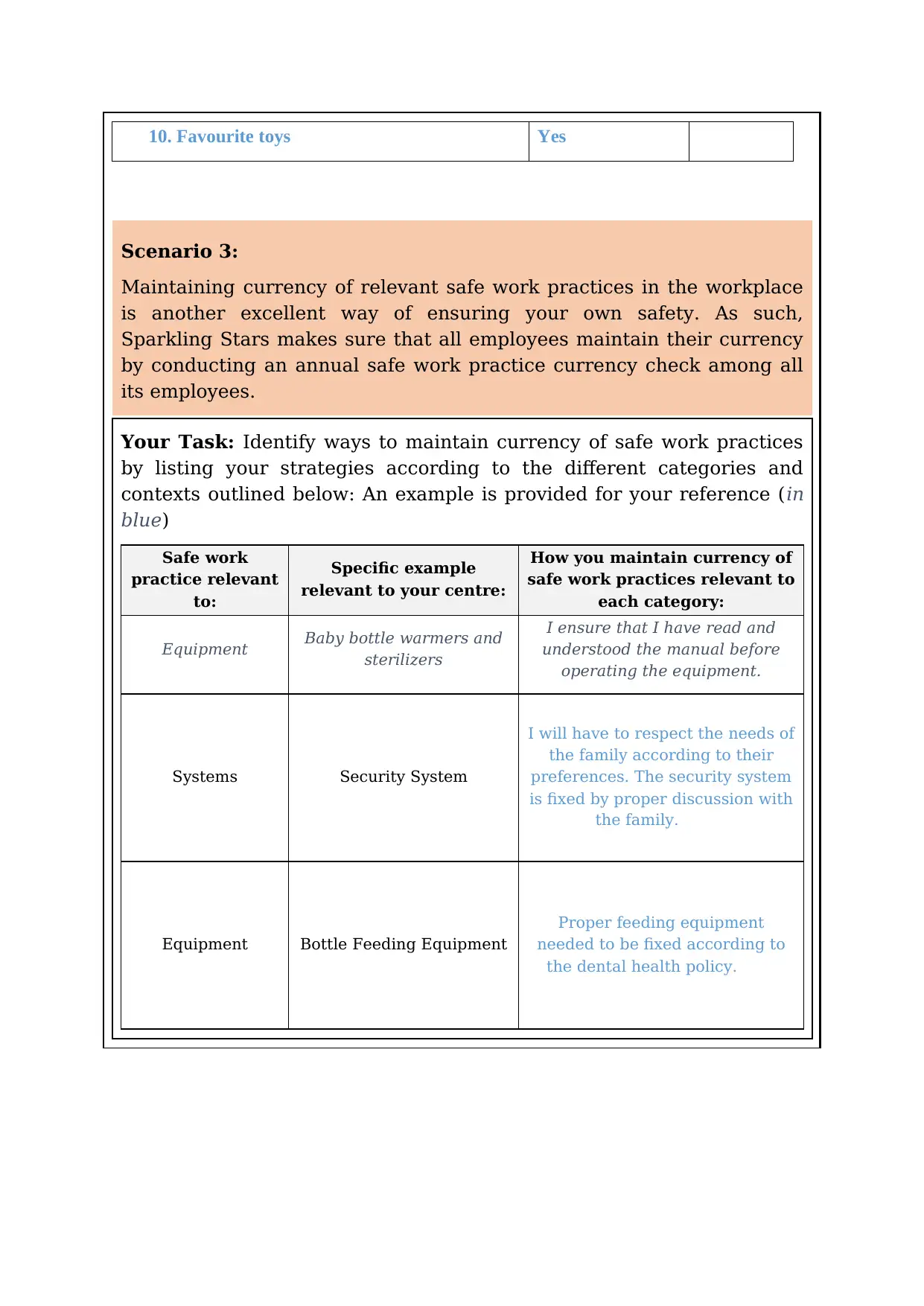
10. Favourite toys Yes
Scenario 3:
Maintaining currency of relevant safe work practices in the workplace
is another excellent way of ensuring your own safety. As such,
Sparkling Stars makes sure that all employees maintain their currency
by conducting an annual safe work practice currency check among all
its employees.
Your Task: Identify ways to maintain currency of safe work practices
by listing your strategies according to the different categories and
contexts outlined below: An example is provided for your reference (in
blue)
Safe work
practice relevant
to:
Specific example
relevant to your centre:
How you maintain currency of
safe work practices relevant to
each category:
Equipment Baby bottle warmers and
sterilizers
I ensure that I have read and
understood the manual before
operating the equipment.
Systems Security System
I will have to respect the needs of
the family according to their
preferences. The security system
is fixed by proper discussion with
the family.
Equipment Bottle Feeding Equipment
Proper feeding equipment
needed to be fixed according to
the dental health policy.
Scenario 3:
Maintaining currency of relevant safe work practices in the workplace
is another excellent way of ensuring your own safety. As such,
Sparkling Stars makes sure that all employees maintain their currency
by conducting an annual safe work practice currency check among all
its employees.
Your Task: Identify ways to maintain currency of safe work practices
by listing your strategies according to the different categories and
contexts outlined below: An example is provided for your reference (in
blue)
Safe work
practice relevant
to:
Specific example
relevant to your centre:
How you maintain currency of
safe work practices relevant to
each category:
Equipment Baby bottle warmers and
sterilizers
I ensure that I have read and
understood the manual before
operating the equipment.
Systems Security System
I will have to respect the needs of
the family according to their
preferences. The security system
is fixed by proper discussion with
the family.
Equipment Bottle Feeding Equipment
Proper feeding equipment
needed to be fixed according to
the dental health policy.
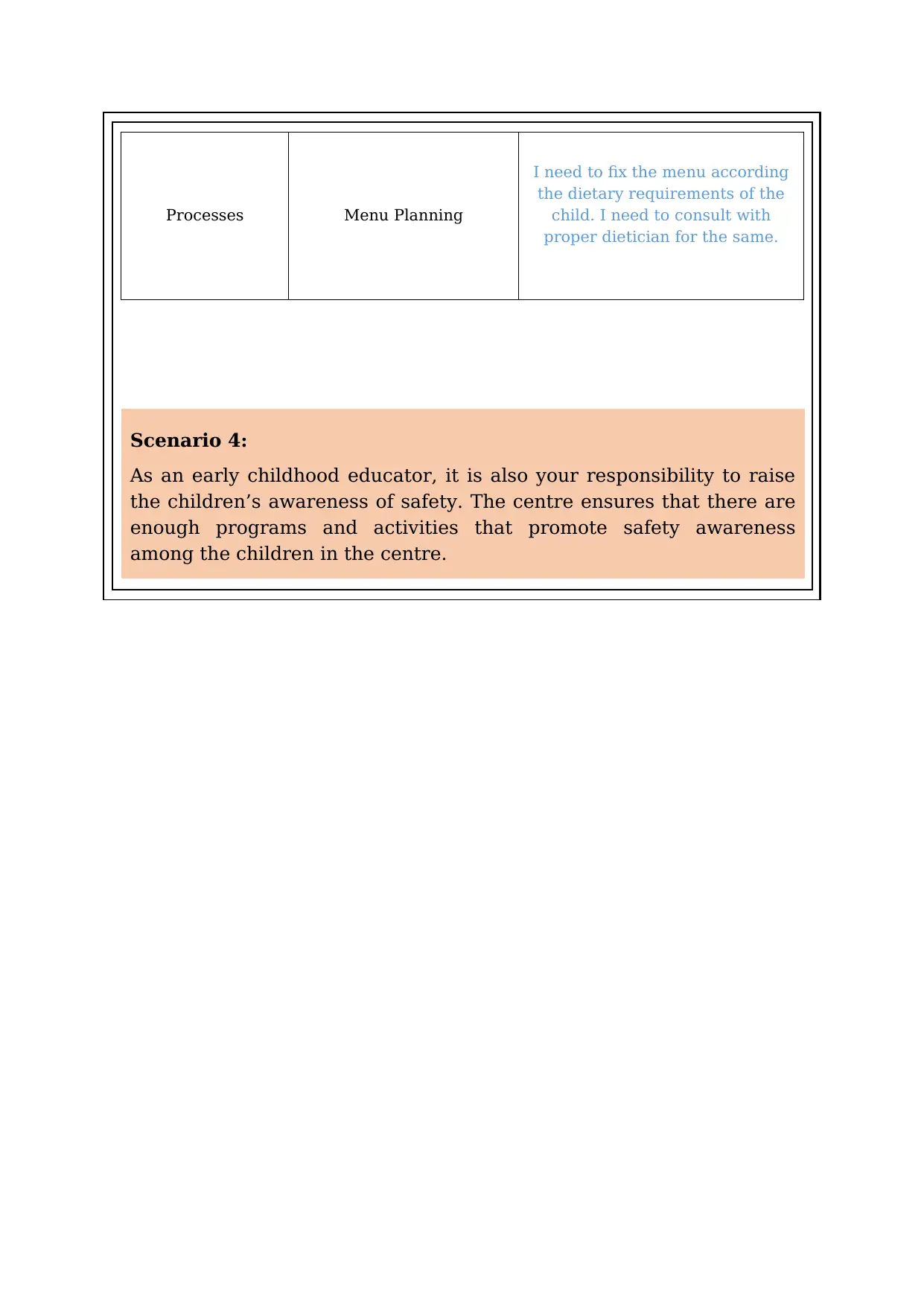
Processes Menu Planning
I need to fix the menu according
the dietary requirements of the
child. I need to consult with
proper dietician for the same.
Scenario 4:
As an early childhood educator, it is also your responsibility to raise
the children’s awareness of safety. The centre ensures that there are
enough programs and activities that promote safety awareness
among the children in the centre.
I need to fix the menu according
the dietary requirements of the
child. I need to consult with
proper dietician for the same.
Scenario 4:
As an early childhood educator, it is also your responsibility to raise
the children’s awareness of safety. The centre ensures that there are
enough programs and activities that promote safety awareness
among the children in the centre.
⊘ This is a preview!⊘
Do you want full access?
Subscribe today to unlock all pages.

Trusted by 1+ million students worldwide
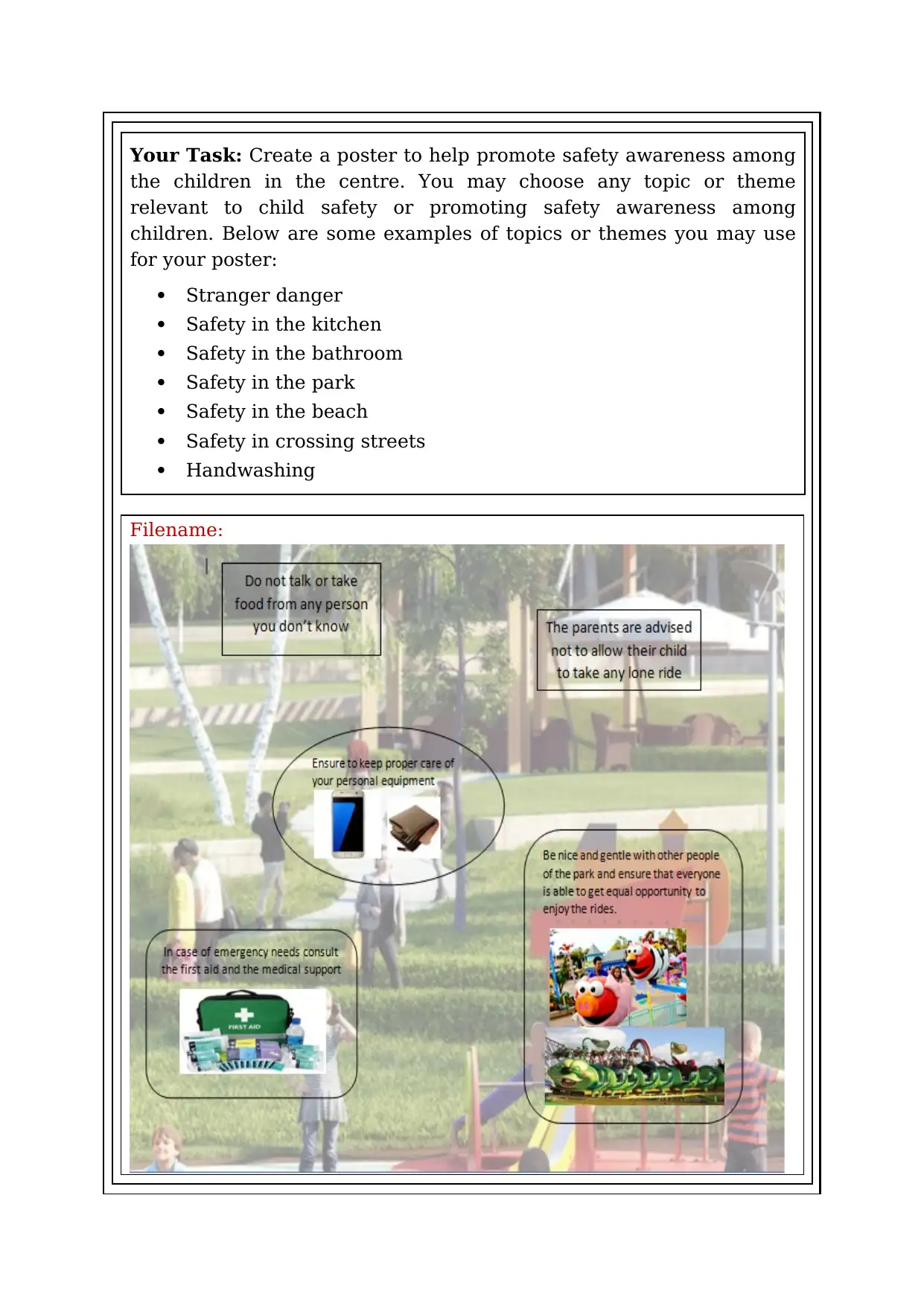
Your Task: Create a poster to help promote safety awareness among
the children in the centre. You may choose any topic or theme
relevant to child safety or promoting safety awareness among
children. Below are some examples of topics or themes you may use
for your poster:
Stranger danger
Safety in the kitchen
Safety in the bathroom
Safety in the park
Safety in the beach
Safety in crossing streets
Handwashing
Filename:
the children in the centre. You may choose any topic or theme
relevant to child safety or promoting safety awareness among
children. Below are some examples of topics or themes you may use
for your poster:
Stranger danger
Safety in the kitchen
Safety in the bathroom
Safety in the park
Safety in the beach
Safety in crossing streets
Handwashing
Filename:
Paraphrase This Document
Need a fresh take? Get an instant paraphrase of this document with our AI Paraphraser
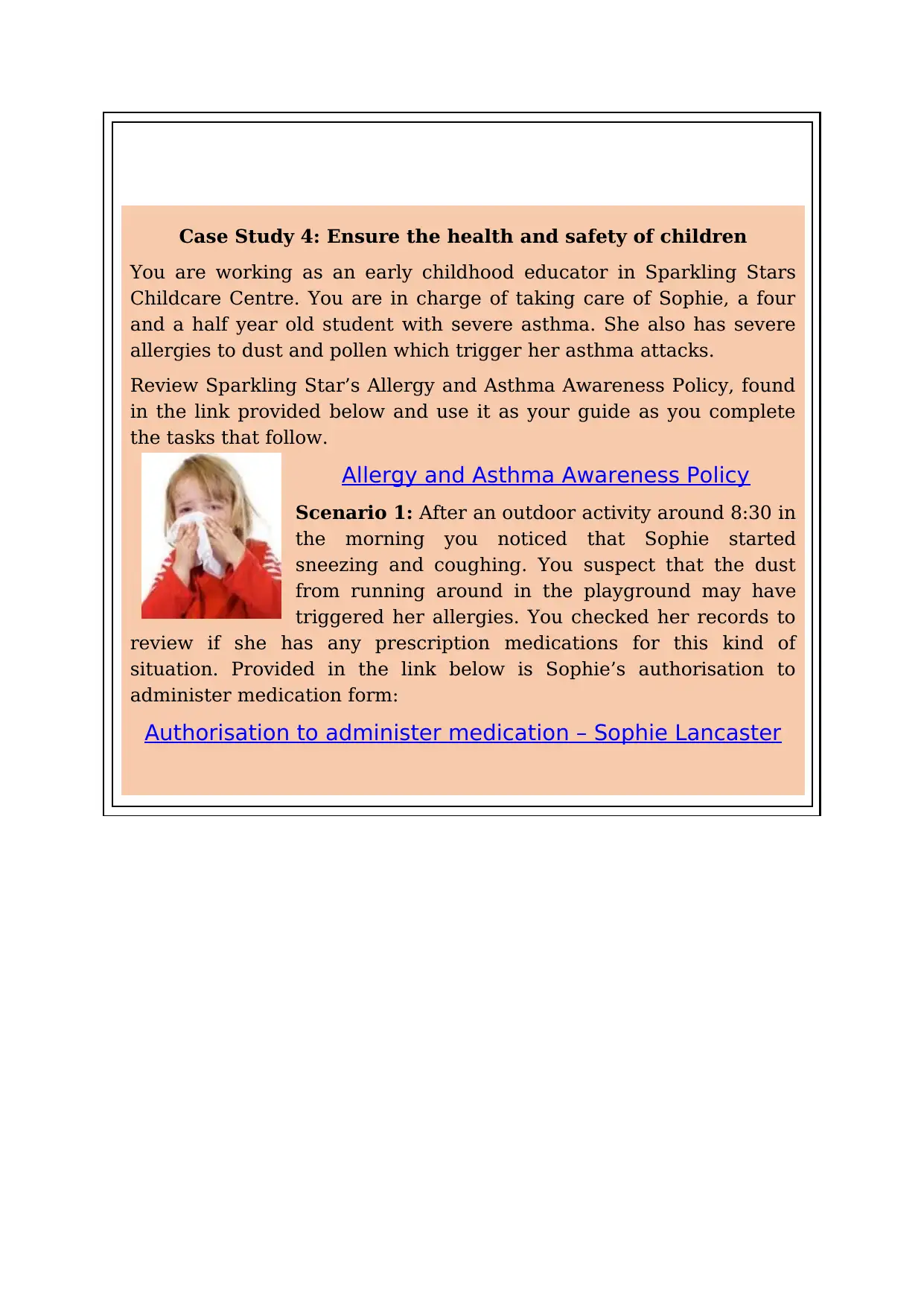
Case Study 4: Ensure the health and safety of children
You are working as an early childhood educator in Sparkling Stars
Childcare Centre. You are in charge of taking care of Sophie, a four
and a half year old student with severe asthma. She also has severe
allergies to dust and pollen which trigger her asthma attacks.
Review Sparkling Star’s Allergy and Asthma Awareness Policy, found
in the link provided below and use it as your guide as you complete
the tasks that follow.
Allergy and Asthma Awareness Policy
Scenario 1: After an outdoor activity around 8:30 in
the morning you noticed that Sophie started
sneezing and coughing. You suspect that the dust
from running around in the playground may have
triggered her allergies. You checked her records to
review if she has any prescription medications for this kind of
situation. Provided in the link below is Sophie’s authorisation to
administer medication form:
Authorisation to administer medication – Sophie Lancaster
You are working as an early childhood educator in Sparkling Stars
Childcare Centre. You are in charge of taking care of Sophie, a four
and a half year old student with severe asthma. She also has severe
allergies to dust and pollen which trigger her asthma attacks.
Review Sparkling Star’s Allergy and Asthma Awareness Policy, found
in the link provided below and use it as your guide as you complete
the tasks that follow.
Allergy and Asthma Awareness Policy
Scenario 1: After an outdoor activity around 8:30 in
the morning you noticed that Sophie started
sneezing and coughing. You suspect that the dust
from running around in the playground may have
triggered her allergies. You checked her records to
review if she has any prescription medications for this kind of
situation. Provided in the link below is Sophie’s authorisation to
administer medication form:
Authorisation to administer medication – Sophie Lancaster
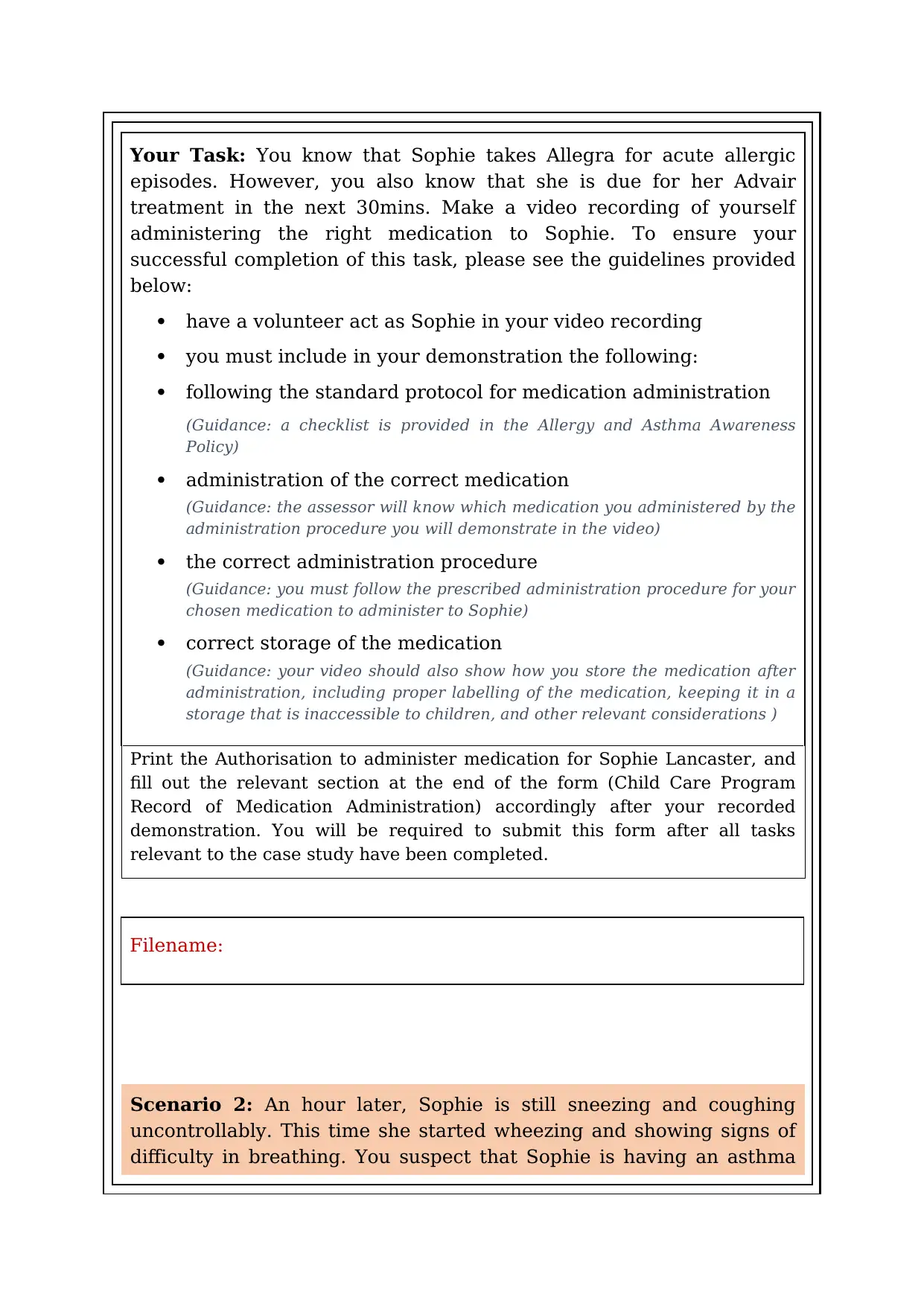
Your Task: You know that Sophie takes Allegra for acute allergic
episodes. However, you also know that she is due for her Advair
treatment in the next 30mins. Make a video recording of yourself
administering the right medication to Sophie. To ensure your
successful completion of this task, please see the guidelines provided
below:
have a volunteer act as Sophie in your video recording
you must include in your demonstration the following:
following the standard protocol for medication administration
(Guidance: a checklist is provided in the Allergy and Asthma Awareness
Policy)
administration of the correct medication
(Guidance: the assessor will know which medication you administered by the
administration procedure you will demonstrate in the video)
the correct administration procedure
(Guidance: you must follow the prescribed administration procedure for your
chosen medication to administer to Sophie)
correct storage of the medication
(Guidance: your video should also show how you store the medication after
administration, including proper labelling of the medication, keeping it in a
storage that is inaccessible to children, and other relevant considerations )
Print the Authorisation to administer medication for Sophie Lancaster, and
fill out the relevant section at the end of the form (Child Care Program
Record of Medication Administration) accordingly after your recorded
demonstration. You will be required to submit this form after all tasks
relevant to the case study have been completed.
Filename:
Scenario 2: An hour later, Sophie is still sneezing and coughing
uncontrollably. This time she started wheezing and showing signs of
difficulty in breathing. You suspect that Sophie is having an asthma
episodes. However, you also know that she is due for her Advair
treatment in the next 30mins. Make a video recording of yourself
administering the right medication to Sophie. To ensure your
successful completion of this task, please see the guidelines provided
below:
have a volunteer act as Sophie in your video recording
you must include in your demonstration the following:
following the standard protocol for medication administration
(Guidance: a checklist is provided in the Allergy and Asthma Awareness
Policy)
administration of the correct medication
(Guidance: the assessor will know which medication you administered by the
administration procedure you will demonstrate in the video)
the correct administration procedure
(Guidance: you must follow the prescribed administration procedure for your
chosen medication to administer to Sophie)
correct storage of the medication
(Guidance: your video should also show how you store the medication after
administration, including proper labelling of the medication, keeping it in a
storage that is inaccessible to children, and other relevant considerations )
Print the Authorisation to administer medication for Sophie Lancaster, and
fill out the relevant section at the end of the form (Child Care Program
Record of Medication Administration) accordingly after your recorded
demonstration. You will be required to submit this form after all tasks
relevant to the case study have been completed.
Filename:
Scenario 2: An hour later, Sophie is still sneezing and coughing
uncontrollably. This time she started wheezing and showing signs of
difficulty in breathing. You suspect that Sophie is having an asthma
⊘ This is a preview!⊘
Do you want full access?
Subscribe today to unlock all pages.

Trusted by 1+ million students worldwide
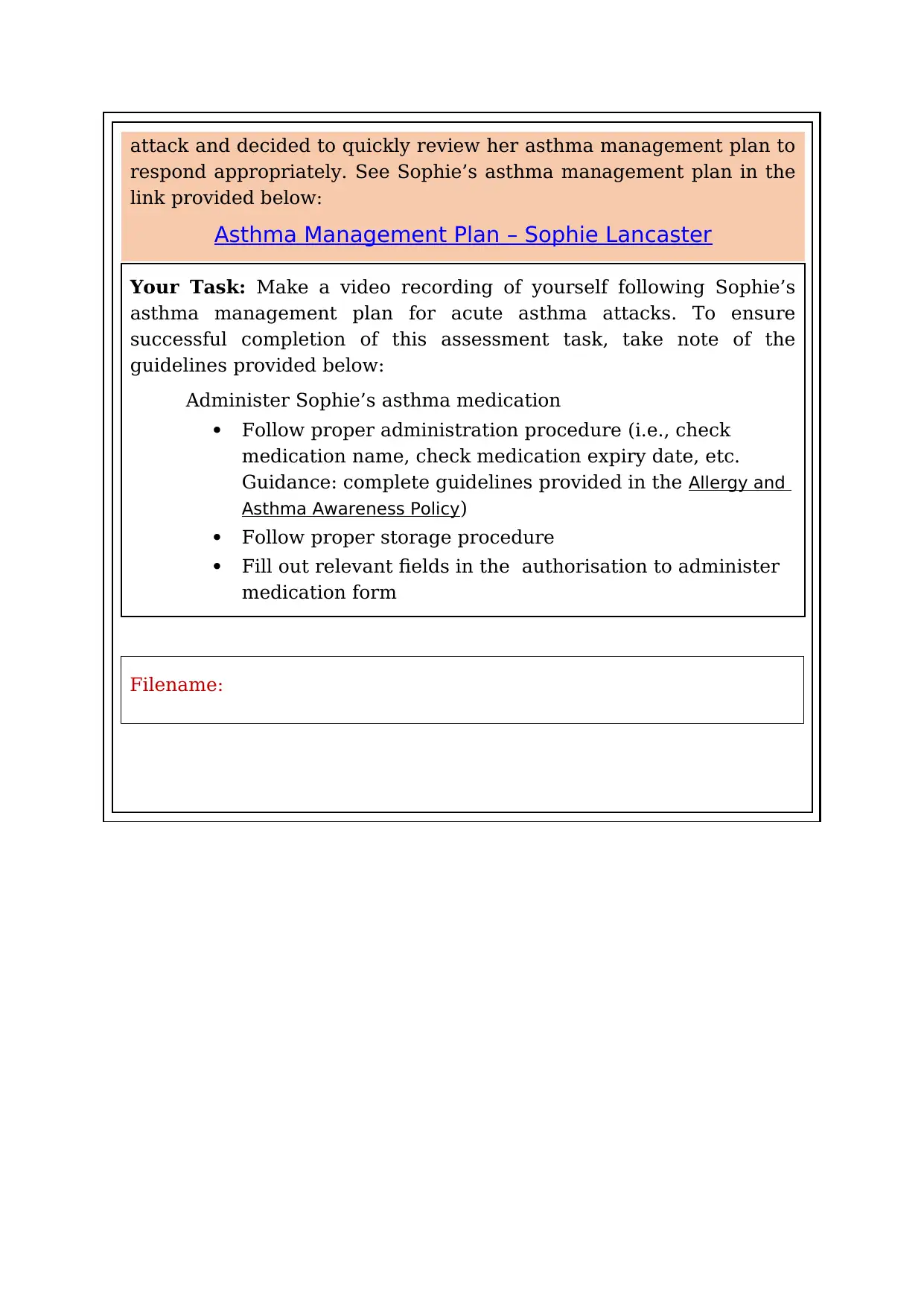
attack and decided to quickly review her asthma management plan to
respond appropriately. See Sophie’s asthma management plan in the
link provided below:
Asthma Management Plan – Sophie Lancaster
Your Task: Make a video recording of yourself following Sophie’s
asthma management plan for acute asthma attacks. To ensure
successful completion of this assessment task, take note of the
guidelines provided below:
Administer Sophie’s asthma medication
Follow proper administration procedure (i.e., check
medication name, check medication expiry date, etc.
Guidance: complete guidelines provided in the Allergy and
Asthma Awareness Policy)
Follow proper storage procedure
Fill out relevant fields in the authorisation to administer
medication form
Filename:
respond appropriately. See Sophie’s asthma management plan in the
link provided below:
Asthma Management Plan – Sophie Lancaster
Your Task: Make a video recording of yourself following Sophie’s
asthma management plan for acute asthma attacks. To ensure
successful completion of this assessment task, take note of the
guidelines provided below:
Administer Sophie’s asthma medication
Follow proper administration procedure (i.e., check
medication name, check medication expiry date, etc.
Guidance: complete guidelines provided in the Allergy and
Asthma Awareness Policy)
Follow proper storage procedure
Fill out relevant fields in the authorisation to administer
medication form
Filename:
Paraphrase This Document
Need a fresh take? Get an instant paraphrase of this document with our AI Paraphraser
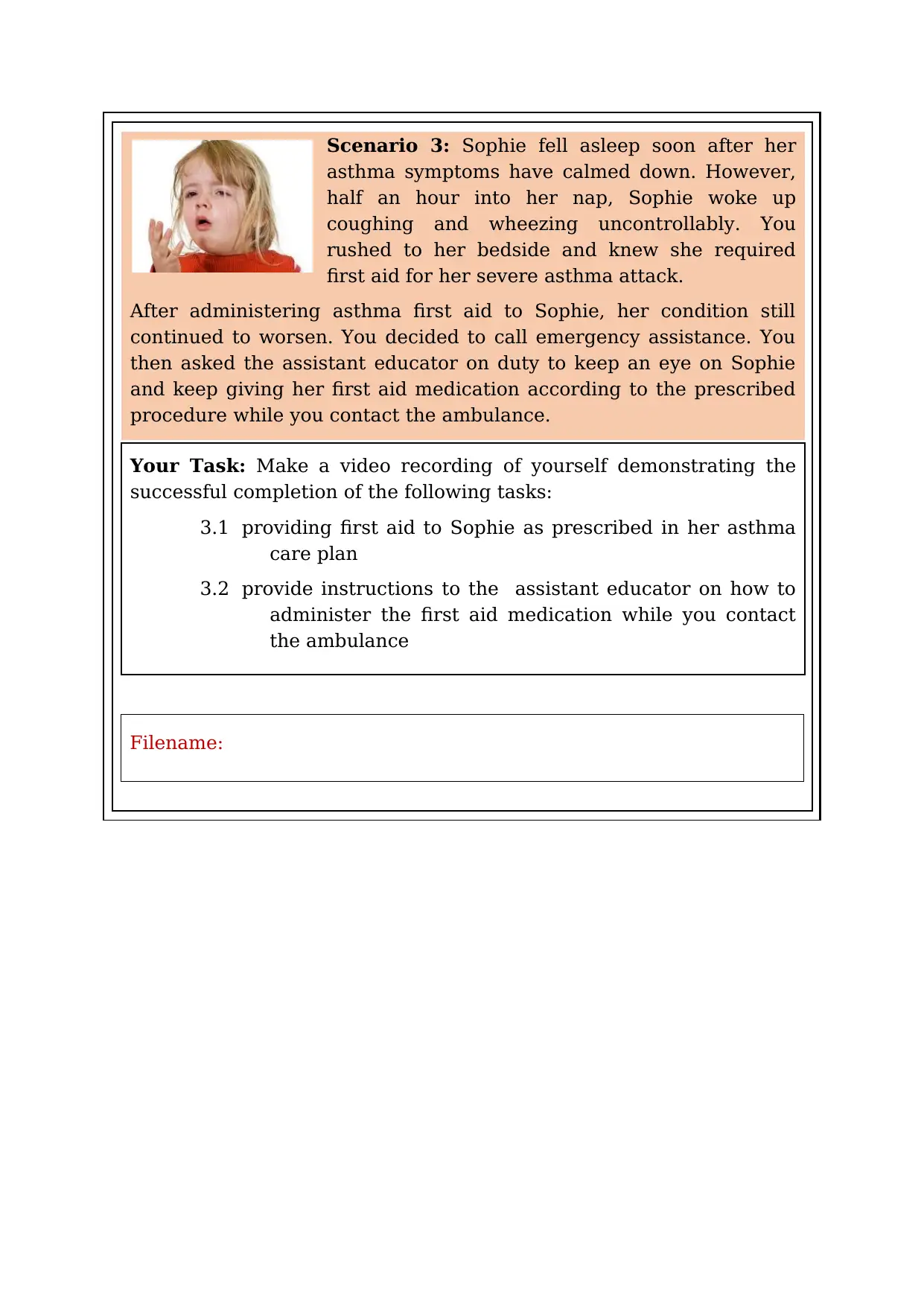
Scenario 3: Sophie fell asleep soon after her
asthma symptoms have calmed down. However,
half an hour into her nap, Sophie woke up
coughing and wheezing uncontrollably. You
rushed to her bedside and knew she required
first aid for her severe asthma attack.
After administering asthma first aid to Sophie, her condition still
continued to worsen. You decided to call emergency assistance. You
then asked the assistant educator on duty to keep an eye on Sophie
and keep giving her first aid medication according to the prescribed
procedure while you contact the ambulance.
Your Task: Make a video recording of yourself demonstrating the
successful completion of the following tasks:
3.1 providing first aid to Sophie as prescribed in her asthma
care plan
3.2 provide instructions to the assistant educator on how to
administer the first aid medication while you contact
the ambulance
Filename:
asthma symptoms have calmed down. However,
half an hour into her nap, Sophie woke up
coughing and wheezing uncontrollably. You
rushed to her bedside and knew she required
first aid for her severe asthma attack.
After administering asthma first aid to Sophie, her condition still
continued to worsen. You decided to call emergency assistance. You
then asked the assistant educator on duty to keep an eye on Sophie
and keep giving her first aid medication according to the prescribed
procedure while you contact the ambulance.
Your Task: Make a video recording of yourself demonstrating the
successful completion of the following tasks:
3.1 providing first aid to Sophie as prescribed in her asthma
care plan
3.2 provide instructions to the assistant educator on how to
administer the first aid medication while you contact
the ambulance
Filename:
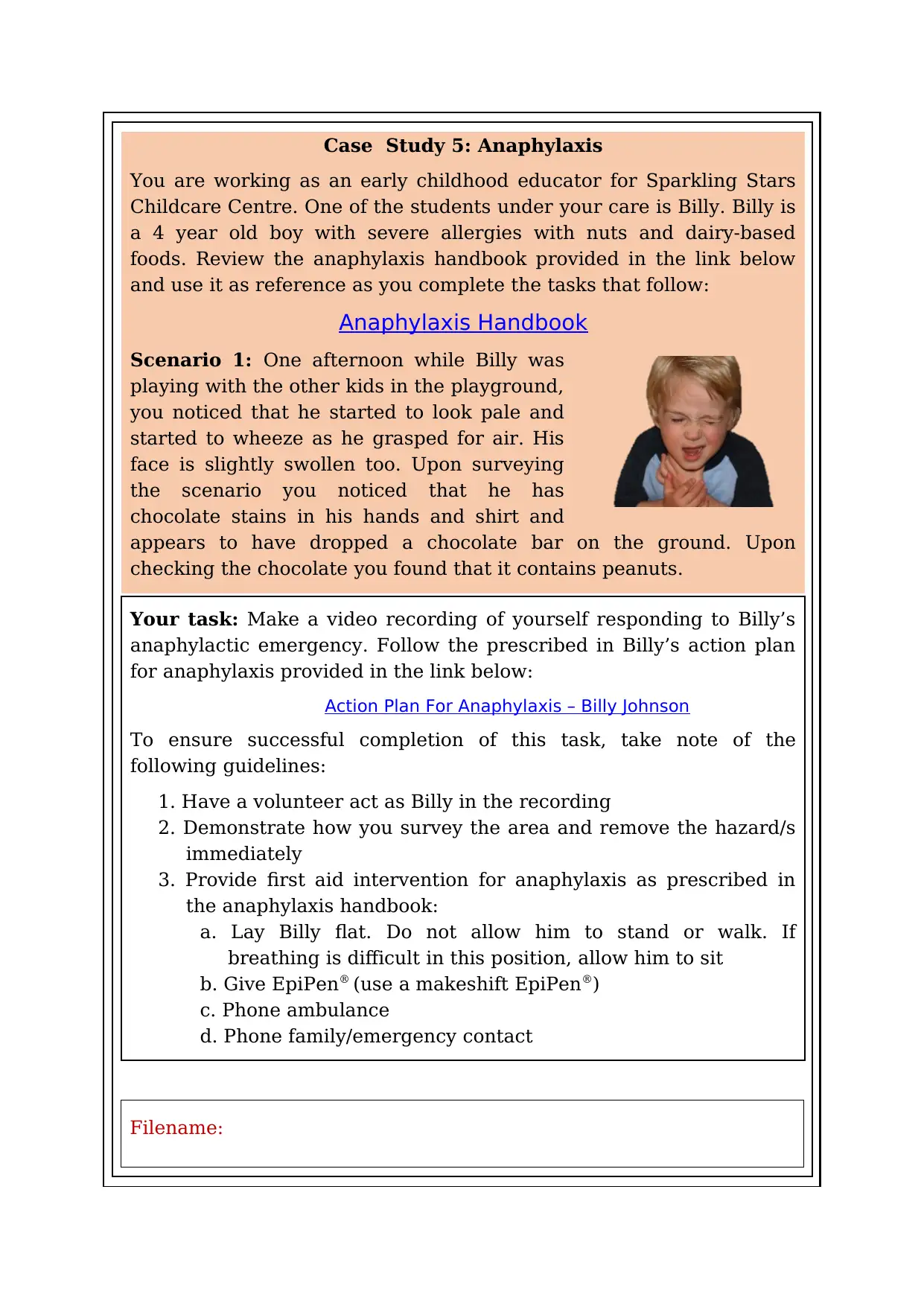
Case Study 5: Anaphylaxis
You are working as an early childhood educator for Sparkling Stars
Childcare Centre. One of the students under your care is Billy. Billy is
a 4 year old boy with severe allergies with nuts and dairy-based
foods. Review the anaphylaxis handbook provided in the link below
and use it as reference as you complete the tasks that follow:
Anaphylaxis Handbook
Scenario 1: One afternoon while Billy was
playing with the other kids in the playground,
you noticed that he started to look pale and
started to wheeze as he grasped for air. His
face is slightly swollen too. Upon surveying
the scenario you noticed that he has
chocolate stains in his hands and shirt and
appears to have dropped a chocolate bar on the ground. Upon
checking the chocolate you found that it contains peanuts.
Your task: Make a video recording of yourself responding to Billy’s
anaphylactic emergency. Follow the prescribed in Billy’s action plan
for anaphylaxis provided in the link below:
Action Plan For Anaphylaxis – Billy Johnson
To ensure successful completion of this task, take note of the
following guidelines:
1. Have a volunteer act as Billy in the recording
2. Demonstrate how you survey the area and remove the hazard/s
immediately
3. Provide first aid intervention for anaphylaxis as prescribed in
the anaphylaxis handbook:
a. Lay Billy flat. Do not allow him to stand or walk. If
breathing is difficult in this position, allow him to sit
b. Give EpiPen® (use a makeshift EpiPen®)
c. Phone ambulance
d. Phone family/emergency contact
Filename:
You are working as an early childhood educator for Sparkling Stars
Childcare Centre. One of the students under your care is Billy. Billy is
a 4 year old boy with severe allergies with nuts and dairy-based
foods. Review the anaphylaxis handbook provided in the link below
and use it as reference as you complete the tasks that follow:
Anaphylaxis Handbook
Scenario 1: One afternoon while Billy was
playing with the other kids in the playground,
you noticed that he started to look pale and
started to wheeze as he grasped for air. His
face is slightly swollen too. Upon surveying
the scenario you noticed that he has
chocolate stains in his hands and shirt and
appears to have dropped a chocolate bar on the ground. Upon
checking the chocolate you found that it contains peanuts.
Your task: Make a video recording of yourself responding to Billy’s
anaphylactic emergency. Follow the prescribed in Billy’s action plan
for anaphylaxis provided in the link below:
Action Plan For Anaphylaxis – Billy Johnson
To ensure successful completion of this task, take note of the
following guidelines:
1. Have a volunteer act as Billy in the recording
2. Demonstrate how you survey the area and remove the hazard/s
immediately
3. Provide first aid intervention for anaphylaxis as prescribed in
the anaphylaxis handbook:
a. Lay Billy flat. Do not allow him to stand or walk. If
breathing is difficult in this position, allow him to sit
b. Give EpiPen® (use a makeshift EpiPen®)
c. Phone ambulance
d. Phone family/emergency contact
Filename:
⊘ This is a preview!⊘
Do you want full access?
Subscribe today to unlock all pages.

Trusted by 1+ million students worldwide
1 out of 27
Your All-in-One AI-Powered Toolkit for Academic Success.
+13062052269
info@desklib.com
Available 24*7 on WhatsApp / Email
![[object Object]](/_next/static/media/star-bottom.7253800d.svg)
Unlock your academic potential
Copyright © 2020–2025 A2Z Services. All Rights Reserved. Developed and managed by ZUCOL.
